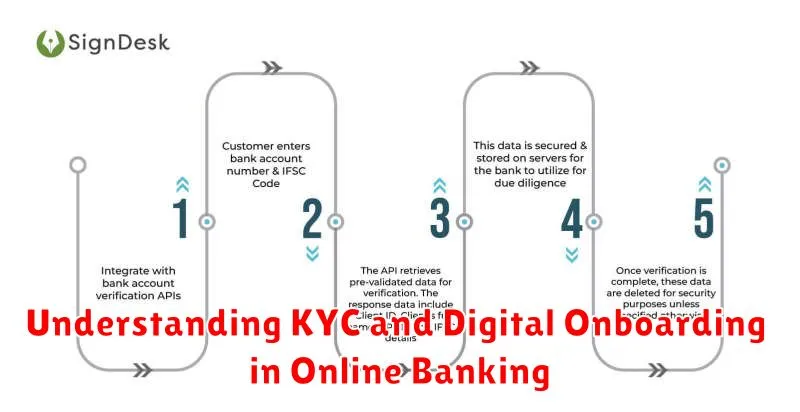In today’s rapidly evolving digital landscape, online banking has become the preferred method for managing finances. This shift necessitates a robust understanding of Know Your Customer (KYC) and digital onboarding processes, which are crucial for both financial institutions and their customers. KYC regulations are designed to prevent financial crimes such as money laundering, terrorist financing, and identity theft. Digital onboarding, the process of bringing new customers onboard remotely, must seamlessly integrate these KYC checks while providing a user-friendly experience. This article explores the intricacies of KYC and digital onboarding within the context of online banking, highlighting their importance in ensuring secure and compliant financial transactions.
Navigating the complexities of KYC compliance and implementing effective digital onboarding solutions can be challenging for banks. From identity verification and customer due diligence (CDD) to ongoing monitoring, various aspects must be considered. This article delves into the key components of KYC and digital onboarding, examining the latest technologies and best practices that streamline the process while maintaining regulatory compliance. We will analyze the benefits of robust KYC/digital onboarding frameworks, including enhanced security, reduced fraud, improved customer experience, and increased operational efficiency for financial institutions embracing the digital transformation of banking.
What Is KYC in Banking?
KYC stands for Know Your Customer. It is a mandatory process for financial institutions like banks to verify the identity of their customers. This process helps to prevent financial crimes such as money laundering, terrorist financing, and identity theft.
Banks use various methods to fulfill KYC requirements. These include collecting official identification documents like passports or driver’s licenses, verifying addresses, and sometimes even conducting background checks. KYC ensures that banks understand who they are doing business with, mitigating risks and maintaining regulatory compliance.
Steps in Digital Onboarding
Digital onboarding streamlines the customer journey for accessing online banking services. It typically involves several key steps:
1. Identity Verification: Customers provide personal information, often verified against official databases. This might include submitting a government-issued ID.
2. Document Upload: Customers may be required to upload supporting documents, such as proof of address.
3. Facial Recognition/Biometric Authentication: Some institutions employ facial recognition or other biometric methods to further verify identity.
4. Agreement and Consent: Customers electronically sign agreements and consent to terms and conditions.
5. Account Creation: Upon successful verification, the online account is created and activated.
ID Verification and Biometric Use

ID verification is a crucial part of KYC. It ensures that the individual opening the account is genuinely who they claim to be. This process typically involves verifying government-issued IDs like passports or driver’s licenses.
Biometrics adds another layer of security and convenience to digital onboarding. Fingerprint scanning, facial recognition, and voice recognition are common biometric methods used to verify customer identity. These technologies allow for quick and secure authentication, streamlining the onboarding process.
The use of biometrics not only strengthens security but also enhances the user experience by simplifying logins and transactions. It minimizes the need to remember complex passwords, reducing friction for customers.
Video KYC and Document Upload
Video KYC is a digital alternative to traditional in-person KYC. It leverages video conferencing technology to verify customer identities remotely. This process typically involves a live video interaction with a KYC agent who guides the customer through verification steps.
These steps often include presenting identification documents to the camera and responding to verification questions. Document upload is a crucial component of both traditional and digital KYC. Customers are generally required to upload digital copies of supporting documents such as government-issued IDs, proof of address, and other relevant paperwork.
This digitized documentation allows for efficient verification and record-keeping. Uploading documents usually involves secure portals or designated platforms within the online banking application.
Reducing Fraud through Automation
Automation plays a crucial role in mitigating fraud during digital onboarding. Automated systems can perform real-time identity verification checks, comparing customer-provided information against various databases and watchlists. This helps to quickly flag potentially fraudulent applications.
Automated risk scoring algorithms analyze multiple data points to assess the risk associated with each applicant. These factors might include geolocation, device information, and behavioral patterns. By assigning risk scores, financial institutions can prioritize high-risk applications for manual review while streamlining the process for low-risk individuals.
Furthermore, automation enables continuous monitoring of customer activity after onboarding. Real-time transaction monitoring can detect suspicious patterns and trigger alerts, enabling faster responses to potential fraud attempts.
Data Privacy and Compliance Standards
Data privacy and regulatory compliance are paramount in digital onboarding. Financial institutions must adhere to various standards to protect sensitive customer information. These standards dictate how data is collected, stored, processed, and shared.
Key regulations include the General Data Protection Regulation (GDPR), the California Consumer Privacy Act (CCPA), and other regional and national laws. Compliance ensures customer trust and minimizes legal risks.
Institutions must implement robust security measures and transparency in data handling practices. This includes providing clear privacy policies and obtaining explicit consent for data usage.
User Experience in Remote Registration
A seamless and intuitive user experience is critical for successful remote registration within online banking. A complicated or frustrating process can lead to abandonment and lost customers.
Key considerations include a streamlined application flow, clear instructions, and easy-to-use identity verification methods. Minimizing data entry and providing real-time feedback enhances the overall experience.
Mobile-first design is also essential, ensuring the registration process is optimized for smartphones and tablets.
Accessibility should be a priority, catering to users with disabilities by adhering to accessibility guidelines.
Challenges in Rural and Low-Tech Areas
Implementing KYC and digital onboarding in rural and low-tech areas presents unique obstacles. Limited internet access and low digital literacy rates pose significant challenges. Many individuals in these regions lack reliable internet connectivity, hindering access to online banking platforms and the ability to complete digital onboarding processes.
Furthermore, a lack of familiarity with technology and digital processes can make it difficult for individuals to understand and navigate online forms and security procedures. This digital divide exacerbates financial exclusion and limits access to essential banking services.
Limited access to required documentation like government-issued IDs and proof of address also poses a challenge. Traditional KYC procedures often rely on physical documents, which can be difficult to obtain or verify in areas with limited infrastructure.
Global KYC Regulations Compared
KYC (Know Your Customer) regulations vary significantly across the globe, influencing how financial institutions conduct due diligence.
Some jurisdictions, like the US and EU, enforce stricter KYC and AML (Anti-Money Laundering) rules, often demanding extensive customer identification and ongoing monitoring. Others may have simpler requirements, especially for lower-risk accounts.
Key differences include the specific identification documents required, the level of customer due diligence needed based on risk assessment, and the regulations surrounding politically exposed persons (PEPs) and sanctions screening.
Future of Seamless Digital Onboarding

The future of digital onboarding lies in creating a truly frictionless experience. This involves leveraging technologies like biometric authentication, artificial intelligence (AI), and machine learning (ML) to automate and streamline KYC/AML checks.
Real-time processing and risk assessment will become the norm, significantly reducing onboarding time. Enhanced security measures will further protect user data and prevent fraud, fostering trust and encouraging wider adoption of digital banking services.
Moving forward, we can expect a shift toward personalized onboarding journeys, tailored to individual customer profiles and risk levels. This will result in a more efficient and user-friendly experience for all.

